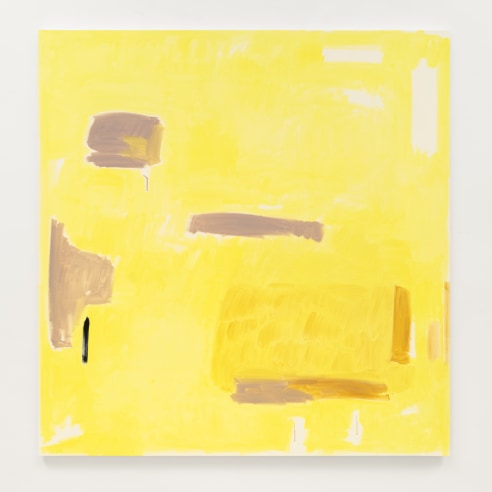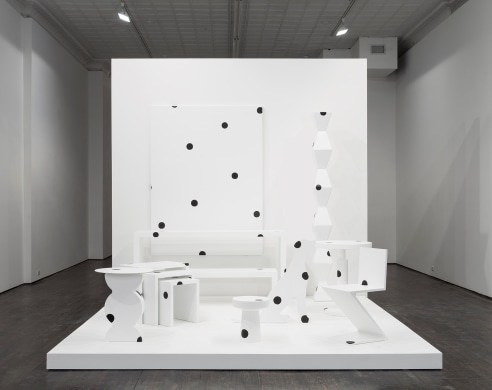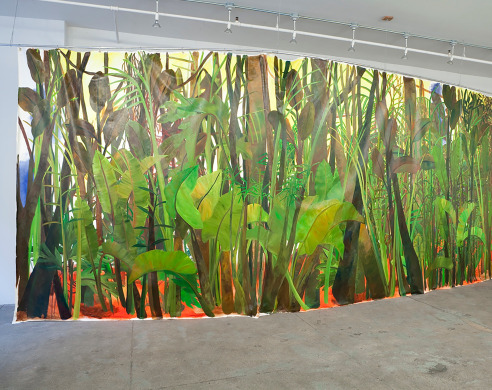
Margaret Lee in Art News
Q & A with Bill Powers

Bill Powers: We are looking at a wall in your studio covered with tear sheets of artwork by Sarah Lucas, Louise Bourgeois, Richard Artschwager, Georgia O’Keeffe, Cady Noland, Superstudio, Louise Lawler—dozens of images.
Margaret Lee: When I don’t know what I’m going to do next, I will take printouts of my older work and intermix them with other things on my mood board.
BP: Is that a picture of Depeche Mode’s Violator album cover?
ML: Yes, I remember buying the tape the day it came out, I was so excited for its release. It was one of the first albums I purchased with my own money, at ten years old. You should watch D. A. Pennebaker’s concert film Depeche Mode 101. I grew up obsessively listening to WDRE (a radio station based on Long Island), and in the film Depeche Mode takes a bunch of teens who won a WDRE radio competition out on tour with them—it’s a taste of reality TV before reality TV was a thing. When I was a pre-teen, I would listen to and tape these WDRE radio shows live from clubs on Long Island. I thought when I grew up that would be my future. I wish I still had those tapes. Anyway, there was a rose in my last show and I used the Violator rose as my inspiration.
BP: I’m friendly with a Korean surfer who grew up in California and whose parents called her a “banana” because she’s Asian on the outside and Caucasian on the inside. Is that part of the subtext behind your fruit sculpture?
ML: I’ve been accused of being a banana in my youth, but that’s not what my sculpture is about. My work has always been about sublimated desire. If you want to relate it directly to a banana, I can say I’m currently more interested in the peeled banana, finding that weird truthy area that is vulnerable, behind the protective layer.
BP: In your last show at Jack Hanley Gallery in New York, everything was painted with dalmatian spots. I’ve always found dalmatians to be a strange breed because they’re kind of Disney and yet have a reputation for being mean.
ML: I sort of like that combination though. And it’s such an ’80s dog. When I was younger, the most glamorous thing I could imagine was a woman in a fur coat walking her dalmatian in SoHo. It was a real signifier of success and opulence.
BP: As someone who uses furniture in her work—or maybe I should say furniture shapes—how would you differentiate between art and design?
ML: There’s a different set of criteria in design, different problems you have to solve: Is this chair comfortable? How can it be fabricated en masse? Can it withstand daily usage? Design starts at functionality.
BP: So you never ask yourself, “Is this art comfortable?”
ML: I joke that art comes from that place when you touch your belly button. It feels really weird and uncomfortable. I don’t know if other people’s belly buttons are sensitive but when I was a kid, I thought the belly button was sensitive because it is the first location of attachment and nourishment. I guess that is why I relate it to creativity. Touching it causes severe discomfort but there is something in that feeling that you want to keep experiencing, because you know it connects you to something larger than yourself.
BP: I read somewhere that you only make art on deadline.
ML: I’ve totally gone against that for the moment. In the beginning, deadlines were helpful, maybe because I was insecure, but I don’t want making art to feel like a job.
BP: Is it strange that your hometown of Yonkers is being hailed as the next art destination?
ML: Very weird. Yonkers was a rough place to grow up; creativity and self-expression were not really encouraged. The public school system was pretty broken and the arts were the least funded. Thankfully, I had a ceramics teacher in high school who loved art and would show us documentaries on people like Louise Bourgeois, Louise Nevelson, Andy Warhol, etc. My favorite was on Alexander Calder’s circus—I don’t think I had ever witnessed such joyfulness in creativity. Yonkers was a segregated city up until 1986. I was in the first grade when the verdict came in and measures were taken to desegregate. It was pretty traumatic to witness the ugliness and anger that emerged in relation to class and race at such a young age. David Simon is making a mini-series about the whole thing for HBO. All the while, I was also being sent to an after-school music program in Scarsdale, which was the complete opposite of my regular school environment.
BP: Was it like that movie Whiplash?
ML: It wasn’t that inspiring. I spent 13 years playing the piano in the most basic way, memorizing and performing pieces that were assigned to me. I was recently listening to Glenn Gould’s Goldberg Variations and there is that humming he does while he plays and it finally hit me, I wish that I had been encouraged to play in that way, where you lose yourself in the music. I was never passionate about playing the piano, I just got really good at sight-reading. After all those years of playing, I don’t consider myself a musician.
BP: One of the artists you represent at your gallery, 47 Canal, is Josh Kline. How did you guys first hook up?
ML: I can’t remember where we first met but we definitely bonded in Joshua Tree. Both of us were there showing art at High Desert Test Sites. Amy Yao invited us out for her annual Swapmeet project. That was also where I forged my friendship with Michele Abeles and Anicka Yi, who are both artists at the gallery. It was a pretty exciting time; the recession had just hit, Obama was newly elected, we were in the desert with a whole group of artist friends—all at the beginning of our careers. There was a lot of driving around in the desert, drinking, sleeping in tents, going to get a sound bath at the Integratron. Looking back, I’m kind of surprised that I went on that trip because I didn’t really know any of the other people and I’m pretty shy and tend to avoid groups.
BP: Has anyone ever pegged you as a hipster?
ML: If anything, I’m more of a secret hippie. My ideal vacation would involve roughing it in nature. I’ve spent some time at a community called Findhorn in Scotland, stayed at Osho’s ashram in Pune, and practiced Kundalini Yoga for years. I used to attend these meetings at a diner on the Upper West Side where a bunch of people would eat burgers with this guy who would talk about how none of us really existed. I’m sort of a reluctant truth seeker. I wish I could go with the flow more, but I don’t like bullshit.
BP: If time machines were real, what advice would you give to yourself starting out in 2009?
ML: Don’t compare yourself to anyone else and don’t measure your success against anyone else’s success.
BP: Gabriel García Márquez said we all live three lives: our public life, our private life, and our secret life. Where does your art come from?
ML: It cycles through all of them. The initial idea is secret and the actualization of the idea in the studio is private. The work ends up public in the exhibition space, but only after a lot of editing. I feel the safest in the secret and the private, but I try to remember that if you are there for too long, it’s easy to get lost.

